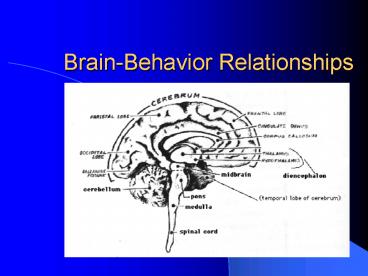BrainBehavior Relationships - PowerPoint PPT Presentation
1 / 29
Title: BrainBehavior Relationships
1
Brain-Behavior Relationships
2
Gross Structures of the Brain
- HINDBRAIN
- Medulla
- Reticular Formation
- Pons and Cerebellum
- MIDBRAIN
- FOREBRAIN
- Diencephalon (Thalamus, Hypothalamus)
- Cerebrum (Basal Ganglia, Limbic System, Cerebral
Cortex)
3
Cerebral Hemispheres
- Basal Ganglia
- 3 main functions
- In current usage, the phrase 'basal ganglia'
means the caudate nucleus, putamen and globus
pallidus. - Limbic System
- 4 structures
- Cerebral Cortex
4
Cortical Connections
- Between hemispheres (e.g., corpus callosum)
- Within a hemisphere, between one lobe and another
(association tracks e.g., arcuate fasciculus) - Cortex-Subcortical (e.g., internal capsule)
5
Review of Neuroanatomy (cont.)
- Skull and Meninges
- Vascular System
- Ventricular System and CSF
6
Principles of Cortical Organization
- Cortical Zones
- Cortical Lobes
- Occipital, Frontal, Parietal, Temporal
- Functional Systems
- Lateralization of Function
7
Cortical Lobes
8
Cortical Lobes
- Occipital Mediate sight visual perception
visual knowledge - Parietal tactile sensations position sense
spatial relations - Left sequential. Logical spatial
- Right holistic spatial information
9
Cortical Lobes (cont.)
- Temporal auditory and olfactory abilities
integrating visual perceptions with other sensory
info new learning emotion motivation - Frontal motor functions, including speech
executive functions integration of emotional and
motivational states
10
Lateralization of Function
- Left Hemisphere
- Speech and Language
- Linear Processing
- Well-routinized codes
- Details
- Contralateral attention
- Positive Emotions
- Right Hemisphere
- Prosody, Humor, Non-literal
- Configural Processing (faces)
- More adept at novel
- Global Percepts
- Global attention
- Negative Emotions
11
Functions
- Attention and arousal (see text)
- Memory (know 4 different regions involved
- Hippocampus surrounding areas
- Basal forebrain (cells that produce
Acetylcholine) - Frontal Cortex
- Basal Ganglia (procedural memory)
- Language
12
(No Transcript)
13
Memory
- Amnesia
- Immediate vs. Long-term
- Remote memory vs. Antereograde memory
- Implicit vs. Explicit Memory
- Frontal Lobes role in retrieval and organization
- The frontal lobes are the most advanced part of
your brain. The frontal lobes are that part of
your brain responsible for creativity, logic,
intuition, new problem solving, synthesis of
ideas, imagination, concepts of time, and
planning.
14
Memory Rehabilitation
Attention
Encoding
Storage
Retrieval
15
Language
- Aphasia
- Expressive Aphasia
- Receptive Aphasia
- Distinguish
- Psychological Issues
16
5 Frontal-Subcortical Circuits
- Motor
- Occulomotor
- Dorsolateral
- Orbitofrontal-Ventral PFC
- Anterior Cingulate
17
PREFRONTAL CORTEX SYSTEMThe most evolved brain
system Functions atention span perseverance
planning judgmen impulse control organization
self-monitoring and supervision problem solving
critical thinking forward thinking learning
from experience and mistakes ability to feel and
express emotions influences the limbic system
empathy internal supervision
18
Major Functional Divisions of Frontal Lobe
19
Dorsolateral Syndrome
- Executive function deficits
- Poor organizational strategies
- Poor memory strategies
- Working Memory
- Impaired set-shifting
- Attentional control (distractible)
20
Orbitofrontal-Ventral PFC Syndrome
- Phineas Gage
- Stimulus-Reward Associations
- Decision-Making
- Appropriate Social Behavior
21
Anterior Cingulate Syndrome
- Akinetic Mutism
- Apathetic, no spontaneous speak, answer in
monosyllables - Display no emotion
22
Points to Remember
- Behavioral deficits determined by site, size,
laterality, nature of lesion, etc. - Individual variation.
- Difficulty to develop real-world tasks to assess
FL functioning.
23
Diseases that commonly affect Frontal functioning
- Affective Disorders
- Depression
- Traumatic Brain Injury
- Schizophrenia
- Some Dementing Illnesses
24
Traumatic Disorders
- Mechanisms of Injury
- Primary
- Secondary
- Initial Assessment of Severity
- Glascow Coma Scale
- Length of Consciousness
- Length of PTA
25
TBI (cont.)
- Treatment
- Cognitive and Emotional Effects
- Rehabilitation
26
Principles of Nerve Cell Communication
- Neuron Membrane
- Electrostatic pressure
- Diffusion
- Communication within a neuron
- Movement of electrical charge
- Communication between neurons
- Electrical signal to chemical signal
27
Biochemical Activity of the Brain
- Membrane of Neuron
- Synapse
- 2 Types of Receptors
- Ionotropic (fast but short-lived)
- Metabotropic (slow, but prolonged effect)
- Either may be excitatory or inhibitory
28
Neurotransmitters
- Excitatory (glutamate)
- Inhibitory (GABA)
- Neuromodulators (dopamine)
29
Classes of Psychoactive Medications
- Neuroleptics (Haldol)
- Antidepresants (Prozac)
- Tranquilizers (diazepam or Valium)
- Stimulants (amphetamine)
- Time Course and Side Effects































